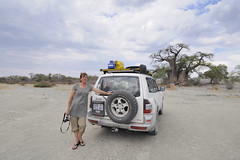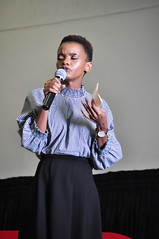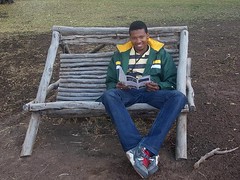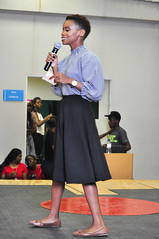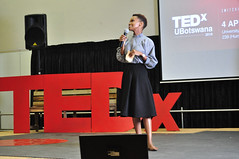 Botswana
Botswana
Botswana (Tswana: Land of the Tswana; English: /bɒtˈswnə/, English: /bʊt-bʊˈw-/), officially the Republic of Botswana (Tswana: Lefatshe la Botswana, Tswana: [lɪˈfatsʰɪ la bʊˈtswana]), is a landlocked country in Southern Africa. Botswana is topographically flat, with approximately 70 percent of its territory being the Kalahari Desert. It is bordered by South Africa to the south and southeast, Namibia to the west and north, and Zimbabwe to the northeast. It is connected by the Kazungula Bridge to Zambia, across the world's shortest border between two countries.
A country of slightly over 2.3 million people, Botswana is one of the most sparsely populated countries in the world. It is essentially the nation state of the Tswana, who make up 79% of the population. About 11.6 percent of the population lives in the capital and largest city, Gaborone. Formerly one of the world's poorest countries—with a GDP per capita of about US$70 per year in the late 1960s—it has since transformed itself into an upper-middle-income country, with one of the world's fastest-growing economies.
Modern-day humans first inhabited the country over 200,000 years ago. The Tswana ethnic group were descended mainly from Bantu-speaking tribes who migrated southward of Africa to modern Botswana around 600 AD, living in tribal enclaves as farmers and herders. In 1885, the British colonised the area and declared a protectorate under the name of Bechuanaland. As decolonisation occurred, Bechuanaland became an independent Commonwealth republic under its current name on 30 September 1966. Since then, it has been a representative republic, with a consistent record of uninterrupted democratic elections and the lowest perceived corruption ranking in Africa since at least 1998.
The economy is dominated by mining, cattle, and tourism. Botswana has a GDP (purchasing power parity) per capita of about $18,113 , one of the highest in Africa. Botswana is the world's biggest diamond producing country. Its relatively high gross national income per capita (by some estimates the fourth-largest in Africa) gives the country a relatively high standard of living and the third-highest Human Development Index of continental Sub-Saharan Africa (after Gabon and South Africa). Botswana is the first African country to host Forbes 30 Under 30 and the 2017 Netball World Youth Cup.
Botswana is a member of the African Union, the Southern African Customs Union, the Southern African Development Community, the Commonwealth of Nations, and the United Nations. The country has been adversely affected by the HIV/AIDS epidemic. In 2002, Botswana became the first country to offer anti-retroviral drugs (ARVs) to help combat the epidemic. Despite the launch of programs to make treatment available and to educate the populace about the epidemic, the number of people with AIDS rose from 290,000 in 2005 to 320,000 in 2013. , Botswana had the third-highest prevalence rate for HIV/AIDS, with roughly 20% of the population infected. However, in recent years the country has made strides in combatting HIV/AIDS, with efforts being made to provide proper treatment and lower the rate of mother-to-child transmission.
Etymology
The country's name means "Land of the Tswana", referring to the dominant ethnic group in Botswana. The Constitution of Botswana recognizes a homogeneous Tswana state. The term Batswana was originally applied to the Tswana, which is still the case. However, it has also come to be used generally as a demonym for all citizens of Botswana.
History
Early history
Archaeological digs demonstrate that hominids lived in Botswana for around two million years. Stone tools and fauna remains have shown that all areas of the country were inhabited at least 400,000 years ago. In October 2019 researchers reported that Botswana was the birthplace of all modern humans about 200,000 years ago.
Evidence left by modern humans, such as cave paintings, is about 73,000 years old. The earliest known inhabitants of southern Africa are thought to have been the forebears of present-day San ("Bushmen") and Khoi peoples. Both groups speak click languages from the small Khoe-Kwadi, Kx’a and Tuu families whose members hunted, gathered, and traded over long distances. When cattle were first introduced about 2000 years ago into southern Africa, pastoralism became a major feature of the economy, since the region had large grasslands free of tsetse fly.It is unclear when Bantu-speaking peoples first moved into the country from the north, although AD 600 seems to be a consensus estimate. In that era the ancestors of the modern-day Kalanga moved into what is now the north-eastern areas of the country. These proto-Kalanga were closely connected to states in Zimbabwe as well as to the Mapungubwe state and the notable of these was Domboshaba ruins, a cultural and heritage site in Botswana originally occupied towards the end of the Great Zimbabwe period (1250–1450 AD), with stone walls that have an average height of 1.8 metres. The site is a respected place for the people living in the region and it is believed that the chief lived on the top of the hill together with his helpers or assistants. These states, located outside of current Botswana's borders, appear to have kept massive herds of cattle in what is now the Central District—apparently at numbers approaching modern cattle density. This massive cattle-raising complex prospered until 1300 AD or so and seems to have regressed following the collapse of Mapungubwe. During this era the first Tswana-speaking groups, the Bakgalagadi, moved into the southern areas of the Kalahari. All these various peoples were connected to trade routes that ran via the Limpopo River to the Indian Ocean, and trade goods from Asia such as beads made their way to Botswana, most likely in exchange for ivory, gold and rhinoceros horn.
Toutswemogala Hill Iron Age Settlement's radio-carbon dates for this settlement range from 7th to late 19th century AD indicating occupation of more than one thousand years. The hill was part of the formation of early states in Southern Africa with cattle keeping as major source of economy. Toutswe settlement include house-floors, large heaps of vitrified cow-dung and burials while the outstanding structure is the stone wall. There are large tracts of centaurs ciliaris, a type of grass which has come to be associated with cattle-keeping settlements in South, Central Africa. Around 700 A.D., the Toutswe people moved westward into Botswana and began an agricultural and pastoral land tenure system based on sorghum and millet, and domesticated stock, respectively. The site was situated in the centre of a broader cultural area in Eastern Botswana and shares many commonalities with other archaeological sites of this region, in both ceramic production styles and also time frames inhabited. Large structures were observed that contained vitrified remains of animal dung, leading to the theory that these were animal enclosures and that Toutswemogala Hill was thus a major centre of animal husbandry in the region. However, agriculture also played a vital role in the longevity of Toutswemogala Hill's extended occupation, as many grain storage structures have also been found on the site. Many different stratified layers of housing floors further signal continuous occupation over hundreds of years.
The arrival of the ancestors of the Tswana-speakers who came to control the region has yet to be dated precisely. Members of the Bakwena, a chieftaincy under a legendary leader named Kgabo II, made their way into the southern Kalahari by AD 1500, at the latest, and his people drove the Bakgalagadi inhabitants west into the desert. Over the years, several offshoots of the Bakwena moved into adjoining territories. The Bangwaketse occupied areas to the west, while the Bangwato moved northeast into formerly Kalanga areas. Not long afterwards, a Bangwato offshoot known as the Batawana migrated into the Okavango Delta, probably in the 1790s.
Effects of the Mfecane and Batswana-Boer Wars
The first written records relating to modern-day Botswana appear in 1824. What these records show is that the Bangwaketse had become the predominant power in the region. Under the rule of Makaba II, the Bangwaketse kept vast herds of cattle in well-protected desert areas, and used their military prowess to raid their neighbours. Other chiefdoms in the area, by this time, had capitals of 10,000 or so and were fairly prosperous. This equilibrium came to end during the Mfecane period, 1823–1843, when a succession of invading peoples from South Africa entered the country. Although the Bangwaketse were able to defeat the invading Bakololo in 1826, over time all the major chiefdoms in Botswana were attacked, weakened, and impoverished. The Bakololo and AmaNdebele raided repeatedly and took large numbers of cattle, women, and children from the Batswana—most of whom were driven into the desert or sanctuary areas such as hilltops and caves. Only after 1843, when the Amandebele moved into western Zimbabwe, did this threat subside.
During the 1840s and 1850s trade with Cape Colony-based merchants opened up and enabled the Batswana chiefdoms to rebuild. The Bakwena, Bangwaketse, Bangwato and Batawana cooperated to control the lucrative ivory trade and then used the proceeds to import horses and guns, which in turn enabled them to establish control over what is now Botswana. This process was largely complete by 1880, and thus the Bushmen, the Kalanga, the Bakgalagadi, and other current minorities were subjugated by the Batswana.
Following the Great Trek, Afrikaners from the Cape Colony established themselves on the borders of Botswana in the Transvaal. In 1852 a coalition of Tswana chiefdoms led by Sechele I defeated Afrikaner incursions at the Battle of Dimawe and, after about eight years of intermittent tensions and hostilities, eventually came to a peace agreement in Potchefstroom in 1860. From that point on, the modern-day borde…
Looking for places related to Botswana?
Those are other destinations to find places related to Botswana:

